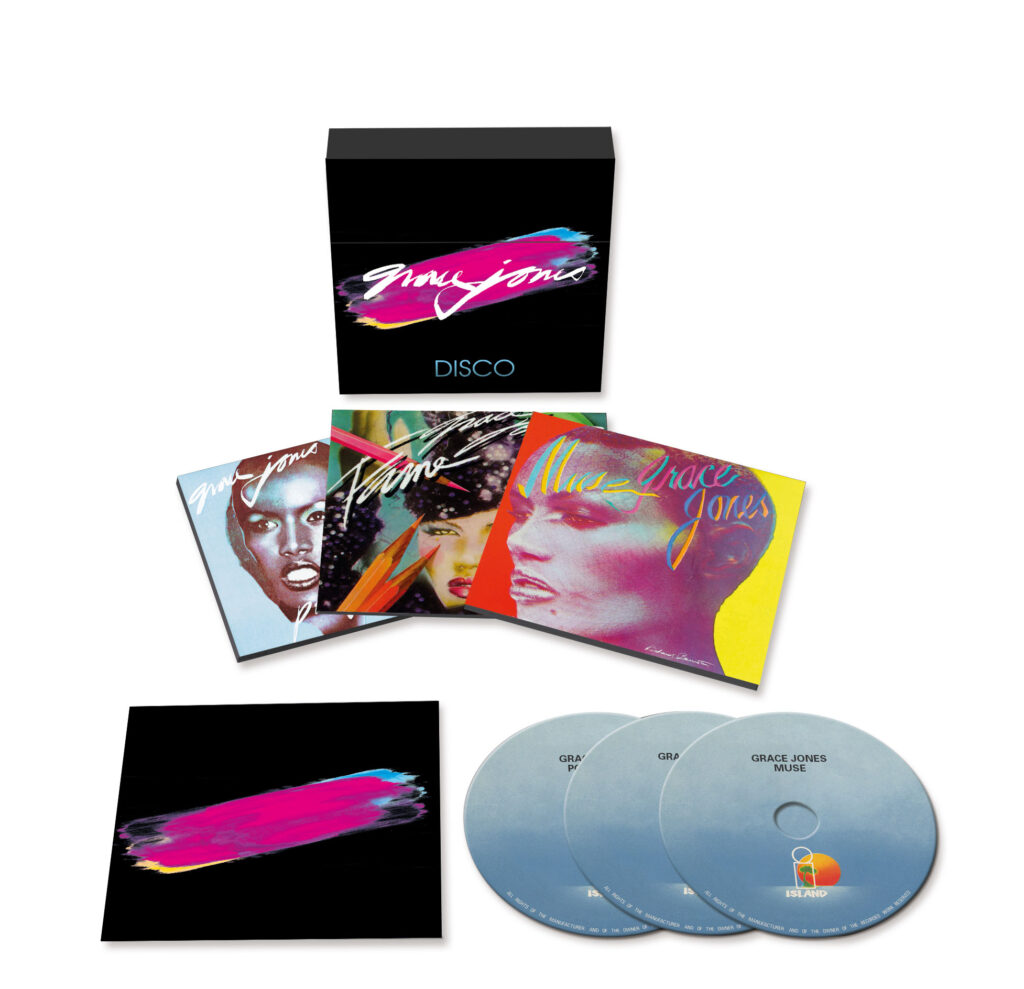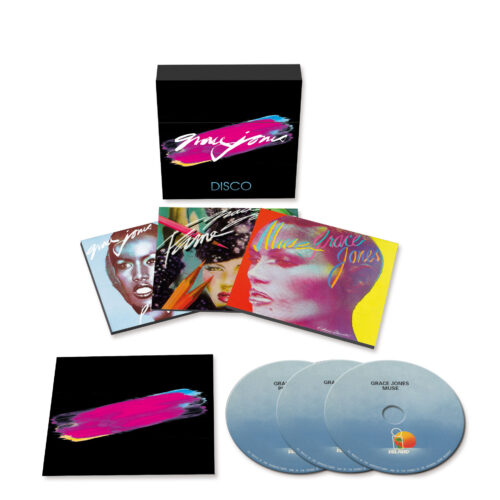We’ve all seen the photographs of Grace Jones at Studio 54 flanked by near-naked musclemen in studded dog collars, or straddling a motorbike with Divine reclining in the foreground. It looks for all the world like the greatest party that ever was, and now with this Disco years boxset being re-released as a complete package for the first time by Island, we can hear a little bit of what those photographs might have sounded like. Of the three albums recorded with undisputed "father of the disco mix", Tom Moulton (he brought the tracks together in one continuous mix on the first side of Gloria Gaynor’s 1975 Never Can Say Goodbye album – the first to do it), Grace Jones’ debut Portfolio has endured where Fame and Muse have fallen away somewhat, with the latter two both out of print and unavailable on streaming services. This lack of appetite from the public almost certainly had everything to do with timing, and nothing at all to do with quality, which we’ll look at in a minute.
Portfolio identifies its target audience and goes for the jugular, with a triptych of Broadway showtunes sat atop hi-NRG rhythms and vigorous strings. It’s easy to forget how liberating disco must have been for minority groups back in the mid-70s, and by minority I mean pretty much anyone who wasn’t white, straight and male; not only was it the sound of liberation, disco was also a defiant raposte to the muso-wankery of Rolling Stone and Creem and the idea disseminated by the media that music had to be serious and made with guitars for it to be "proper". Grace sets out her stall with the Stephen Sondheim classic ‘Send In The Clowns’ (also covered by camp icons like Shirley Bassey, Barbra Streisand, Cher, Tiger Lilies and even Judi Dench later along the way), followed by ‘What I Did For Love’ from A Chorus Line and ‘Tomorrow’ from Annie. She performs them with her inimitable composure, and unleashes that rare genie from the bottle we like to call "star quality", where so many others would have tipped these songs over into amdram. The album also includes her first ever single, ‘I Need A Man’, originally released on Beam Junction in the US and French label Orfeus, as Grace was still working as a fashion model in Paris in 1977. Second single ‘Sorry’ was self-penned alongside her then writing partner Pierre Papadiamondis, and it stands up to any of the standards on side A of the album, written by some of the most renowned working songsmiths of the day.
Best of all though is her rendition of Edith Piaf’s ‘La Vie En Rose’. This cover is Grace Jones’ first true classic, which for my money takes the raw emotion of the original and turns it into something far more romantic and sunkissed in keeping with the optimistic title of the song. Grace had learnt to speak French fluently from working so often in Paris; here she interchanges between French and English seamlessly. On second album Fame, Moulton and Jones try the same tricks again on ‘Autumn Leaves’, which, with its clipped bossa nova beat, crisp, insistent acoustic guitar, peripatetic fretless bass and lilting, dreamlike mood, nearly captures again the glory of ‘La Vie En Rose’, though its a little too akin to the first effort not to make you feel confused and a little suspicious, like seeing a Braque hung next to a Picasso in a gallery.
By 1978, Jones was already an androgynous icon. On the back cover of Fame she stares out at you with a sailor cap tilted to one side demonstrating her ability to laugh at herself, while on the controversial Italian TV show Stryx – which was taken off air after just six episodes because it was too racy even for the Italians (or more likely too blasphemous) – Grace astonishes in leopard skin gloves and slinky negligee, writhing around in a shag pile carpet while a real tiger watches on menacingly from the side of a set decked out to resemble Hades.
Fame is perhaps even more sumptuous than its predecessor, with its vertiginous orchestration, tabla breakdowns and ostentatious harps thrown in here and there. Tunes like opener ‘Do Or Die’ exceed the BPM one has become accustomed to with disco records, keeping everyone on their toes. If there was less demand for the second record, then perhaps it was because the market had become saturated with disco in 1978, with so much of it now inevitably lacking in quality; 1977 had taken disco overground and into the mainstream with songs like Donna Summer and Giorgio Moroder’s ‘I Feel Love’ and the Bee Gees’ ‘Staying Alive’ and ‘Night Fever’; 1978 was all about Boney M’s ‘Rivers Of Babylon’ and ‘Rasputin’ and Sarah Brightman and Hot Gossip’s ‘I Lost My Heart To A Starship Trooper’.
1979 saw a backlash against disco, and unfortunately Grace Jones’ Muse got lost in the melee. It’s a shame, because it might be the best of the lot. These re-releases should hopefully precipitate a long overdue reassessment, or even make people aware Jones’ music career didn’t start with Warm Leatherette. Muse sees the introduction of the brilliantly named Icelandic keyboard player Thor Baldursson, who not only duets with Jones on ‘Suffer’, but also takes hold of some of the arrangements, with one presuming he was responsible for the cool, arabesque instrumentation that cascades over the insistent opener ‘Sinning’. Grace proudly declares herself a "bitch", a "witch" and says she’s "as bad as I can be" (or is it "badass"?) on the opening track. ‘Suffer’ meanwhile revels in the sadomasochistic, with the sound of an electric whip cracking as Baldursson shouts "take that! And that!" with Grace emitting groans of pleasure at the outset – it’s high camp with some sexual karate thrown in for good measure. There’s little on Muse to indicate which direction Grace Jones would move in afterwards, though ‘Atlantic City Gambler’ has a languorous and breezy summery quality that she’d explore much deeper with Sly and Robbie on Warm Leatherette, and ‘On Your Knees’ – the only single to be released from the album, presumably because it bombed – anticipates Nightclubbing‘s ‘Pull Up To The Bumper’ in the verses, even if it’s not as good (though what is?).
If that lot isn’t enough to tide you over, then the boxset is full of extended mixes, instrumentals and 12" disco versions. It’s a lot to get through, but these tracks sound as fresh and vital as when they left the studio and pitched up at Studio 54, and this time the audience should be far more receptive than the fatigued punters of 1979, who’d all but had it with the genre.
<div class="fb-comments" data-href="http://thequietus.com/articles/17650-grace-jones-disco-review” data-width="550">



